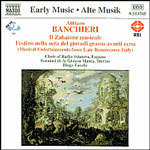
Il Zabaione Musicale (Musical Entertainments)
 $25.00
Out of Stock
$25.00
Out of Stock6+ weeks add to cart
ADRIANO BANCHIERI
Il Zabaione Musicale (Musical Entertainments)
Radio Svizzera Italiana Choir; Sonatori de la Gioiosa Marca; Diego Fasolis, conductor
[ Naxos Early Music / CD ]
Release Date: Tuesday 6 January 2004
This item is currently out of stock. It may take 6 or more weeks to obtain from when you place your order as this is a specialist product.
"The style of interpretation might fairly be described as all out"
- Fanfare
"Fasolis draws singing from his Lugano choir, with incisively crisp ensemble, colourfully enhanced by brass and timpani"
- Penguin Guide
Adriano Banchieri was a man of considerable versatility, a composer, dramatist, organist and theorist. Born in Bologna in 1568, he studied the organ and composition as a pupil of Giose!lo Guami, who had himself studied with Adrian Willaert and Annibale Padovano as a member of the musical establishment at St Mark's in Venice, where he was later second organist under Giovanni Gabrieli, before returning to his native Lucca as organist at the cathedral there. Banchieri entered the Olivetan monastic order in 1587, taking the name in religion of Adriano and in 1590 making his solemn profession. Thereafter he was employed at various houses of his order, serving as organist in Lucca in 1592, in Siena the following year and from 1596 at S Michele in Bosco near Bologna, where he had moved in 1594. His term of service there was interrupted from 1600 to 1604, when he was organist at S Maria in Regola at Imola, followed by employment at the monastery of S Pietro at Gubbio and subsequently at churches in Venice and in Verona. In 1607 he dedicated the new organ at the Siena mother-house of his order, Monte Oliveto Maggiore. In 1609 he returned to S Michele in Bosco. There, in 1615, he founded the Accademia dei Floridi, assuming the name of II dissonante, following the usual practice of these enthusiastic groups of scholars, musicians and amateurs, the members of which took more or less appropriate pseudonyms. Monteverdi visited the Accademia in 1620 on the occasion of his eldest son Francesco's entry into the order of Discalced Carmelites, where, presumably, he hoped to continue his activities as a musician. The Accademia held a meeting on 13th June, the feast of St Anthony of Padua, in Monteverdi's honour, with the additional presence of a number of leading musicians from Bologna, including Girolamo Giacobbi, maestro di cappella at the basilica of S Petronio, an important musical centre, a close friend of Banchieri. The Accademia changed its name to the Accademia dei Filomusi in 1622, when it began to meet in the house of Girolamo Giacobbi, a change followed by the emergence in 1633 of the Accademia dei Filaschi, the direct progenitor of the influential Accademia Filarmonica of Bologna, established in 1666. Banchieri was given the honorary title of Abbot in 1618, moving to S Bernardo in Bologna only in 1634, the year of his death from apoplexy.
Tracks:
Il Zabaione musicale
01. I. Introduzione 01:30
02. Atto I: II. Prologo: l'Humor spensierato 00:46
03. Atto I: III. Intermedio di felici pastori, a due cori 01:36
04. Atto I: IV. Progne e Filomena 01:36
05. Atto I: V. Danza di pastorelle, in aria del spagnoletto, con le riprese nella cornamusa 01:05
06. Atto I: VI. Madrigale: Soavissimo ardore 01:42
07. Atto II: VII. Intermedio di pignattari 01:14
08. Atto II: VIII. Un pastorello con un augellino uccisogli da un gatto 01:35
09. Atto II: IX. Tirsi a Clori 01:44
10. Atto II: X. Dialogo: Aminta, Dafne e giudizio d'Amore 01:00
11. Atto II: XI. Gioco della passerina 01:44
12. Atto II: XII. Madrigale: Baci, sospir e voci 02:26
13. Atto III: XIII. Ergasto appasionato 02:13
14. Atto III: XIV. Preparamento pastorale 01:07
15. Atto III: XV. Gara amorosa di pastori 02:36
16. Atto III: XVI. Danza di ninfe e pastori 01:54
17. Atto III: XVII. Licenza: l'Humore spensierato 00:59
Festino nella sera del giovedì grasso avanti cena, Op. 18
18. I. Il diletto moderno per introduzione 01:09
19. II. Giustiniana di vicchietti chiozzotti 01:37
20. III. Mascherata di villanelle 02:31
21. IV. Seguita la detta mascherata 01:45
22. V. Madrigale a un dolce usiglio 02:41
23. VI. Mascherata d'amanti 00:41
24. VII. Gli amanti morescano 01:08
25. VIII. Gli amanti cantano un madrigale 02:08
26. IX. Gli amanti cantano una canzonetta 01:48
27. X. La zia Bernardina racconta una novella 01:59
28. XI. Capricciata a tre voci 01:21
29. XII. Contrappunto bestiale alla mente 01:32
30. XIII. I cervellini cantano un madrigale 02:07
31. XIV. Intermedio di venditori di fusi 01:13
32. XV. Li fusari cantano un madrigale 02:06
33. XVI. Gioco del conte 02:00
34. XVIIa. Li festinanti (solo di scacciapensieri: Marco Beasley) 00:55
35. XVIIb 01:06
36. XVIII. Vinata di brindesi e ragioni 02:59
37. XIX. Sproposito di goffi (pero di gusto) 01:30
38. XX. Il diletto moderno licenza e di nuovo invita 01:13

